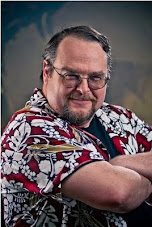Le Livre Des Fourmis (The Book of Ants) by Robin D. Laws, Pelgrane Press, 2014.
 Provenance: Purchased at GenCon from Robin D. Laws, who also gave his autograph with the note: Vive la Revolution Surrealiste!
Provenance: Purchased at GenCon from Robin D. Laws, who also gave his autograph with the note: Vive la Revolution Surrealiste!I don't review game products here. Wait, let me back up and clarify that on two points. I don't review game products that I have not actually played. Reviewing a game based on the printed word is sort of like reviewing a play by reading the script - it doesn't tell the full story. There are numerous reviews of adventures that I have run for our Call of Cthulhu group. The other clarification is that I promote other people's games without fear, particularly if they've just released something. For me to delay a review due to my slow reading habits should not stand in the way of you finding out about cool and new stuff.
Anyway, this is bit of fiction in that it ties into a recently published adventure setting called Bookhounds of Paris, which uses the Trail of Cthulhu game system. I've played Trail of Cthulhu, though have not run it (the amazing Steve Winter was the GM), and don't have the game product that might illuminate this further. But it stands on its own as a nicely weird merger of the Cthulhu Mythos (in particular the Dreamlands) with the avant garde artists of the interwar period.
The volume is presented as a diary (in the form that CoC players know well) by Henri Salem, a supposedly minor player in the artistic politics in Paris between the wars. He hangs with Andre Breton, Jacques Vache, Pablo Picasso, Max Ernst, and Salvador Dali (yeah, keep your Wikipedia open - I knew about half these guys before I started in on the work). They are a cliquish and diverse group, continually squabbling and factionalizing as they try to move forward (or backwards, or sidewards) the cause of Surrealism and thereby change the world. In the midst of this Salem's bunch discovers how to access the Dreamlands.
The Dreamlands were a Lovecraftian creation, a setting for many stories and in particular poems. Expanded and explored over the years in stories and games by other hands, they have their own parrallel existence. The surrealistic movement of the 20s and 30s worked to break down the walls between the conscious and unconscious nature of man, between dreams and reality. They considered what they were doing a form of enlightenment, a philosopher of which its art was considered mere artifact, by-product of the process of awakening and overturning the world. They are perfect candidates for exploring the Dreamlands.
The cool thing is, that in discovering the Dreamlands, the surrealists begin to change them. As opposed to a traditional fantasy domain, these Dreamlands are more fluid, responding the power of the dreamers themselves. So the Surrealists do change the world, only not the one they are thinking of.
I really like this for this effect, and by Laws way of threading the reality of the movement and its petty politics in with the arcane and mystical. Being Lovecraftian, things end badly for those involved, as it does in the real world for many of the participants. The book is an engaging, twisted melding of two great flavors, and now I suppose I must hunt down the game product to see what they did with it there.
More later,
















